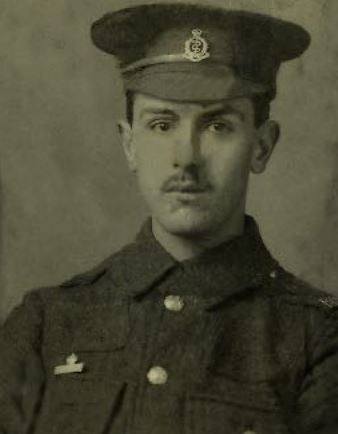2/3rd North Midland Field Ambulance, Royal Army Medical Corps

Reginald Johnson was the son of George Samuel Johnson and his wife Alice Mary. According to the 1911 Census thirteen children were born to the couple inside twenty-five years of marriage of whom only seven were surviving at the time of the census. Reginald was the oldest male of those surviving and he had one other brother (Walter) and five sisters (Rosalie, Florence, Blanche, Edith and Alice). The family lived at 119 Tredworth Road, Gloucester and George Johnson was employed at a ‘match manufacturer’, probably at the nearby Morelands match factory.
Reginald was born at Highworth, near Swindon, Wiltshire in the second half of 1894 and at the time of the 1911 Census was employed as a hairdresser.
It is possible that in the years between 1911 and the outbreak of war he had moved to the West Midlands as, according to Soldiers Died in the Great War he enlisted in the Army at Wolverhampton: the 3rd North Midland Field Ambulance (NMFA) had their headquarters at The Deanery, Stafford Street, Wolverhampton. Unfortunately no Army service record has survived for Reginald, so his date of enlistment is unknown but it was probably in late 1914 or early 1915.
The 2/3rd NMFA was originally part of 2nd North Midland Division, which became 59 Division. It was a Territorial Force unit, based in the Luton area from January 1915 before moving to St Albans in July of that year. It was not posted abroad during the time Private Johnson was serving with it and the absence of a Medal Index Card is a strong indicator that his Army service was confined to the UK.
A death notice in the Gloucestershire Journal of 1 April 1916 stated that he had died on 29 March 1916, aged 21, at Bricket House Hospital, Bricket Road, St Albans: presumably of illness. His funeral (on 4 April) was reported in the 8 April edition of that newspaper. He was buried in Gloucester Old Cemetery, where a flat private headstone marks his grave. In 1930 his mother was buried in the same plot (aged 65) and his father followed, aged 90, in 1955. Private Johnson is commemorated on the Gloucester War Memorial.
Bricket House Hospital was a large mansion rented out as a hospital for the duration of the Great War. In March 1915 it became St Albans VAD Auxiliary Hospital, with beds for 35 sick or wounded and it closed in 1918. The building retained some medical facilities until after World War Two and it burnt down in 1983 and the site now houses an office block.

Researched by Graham Adams 26 July 2018
